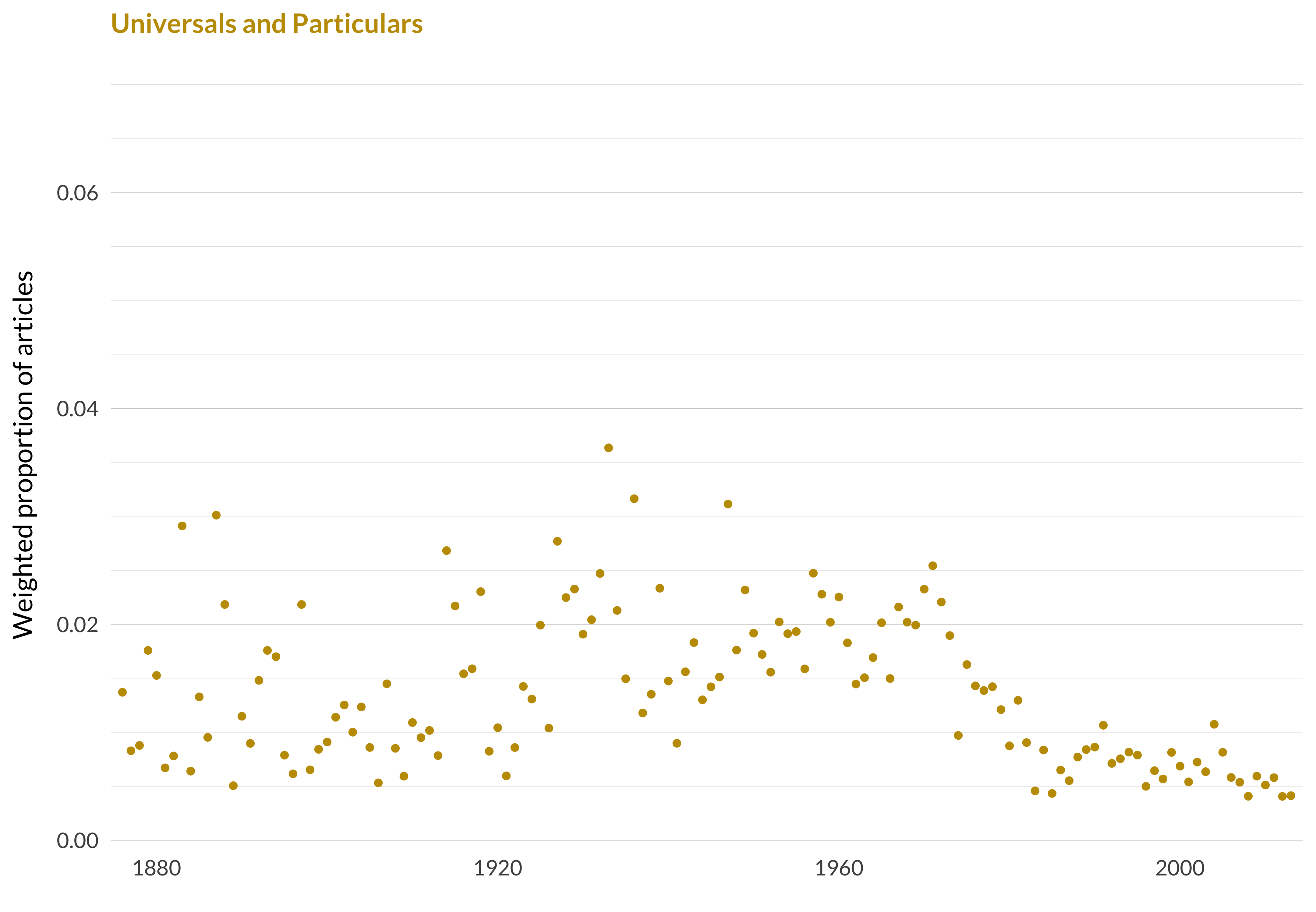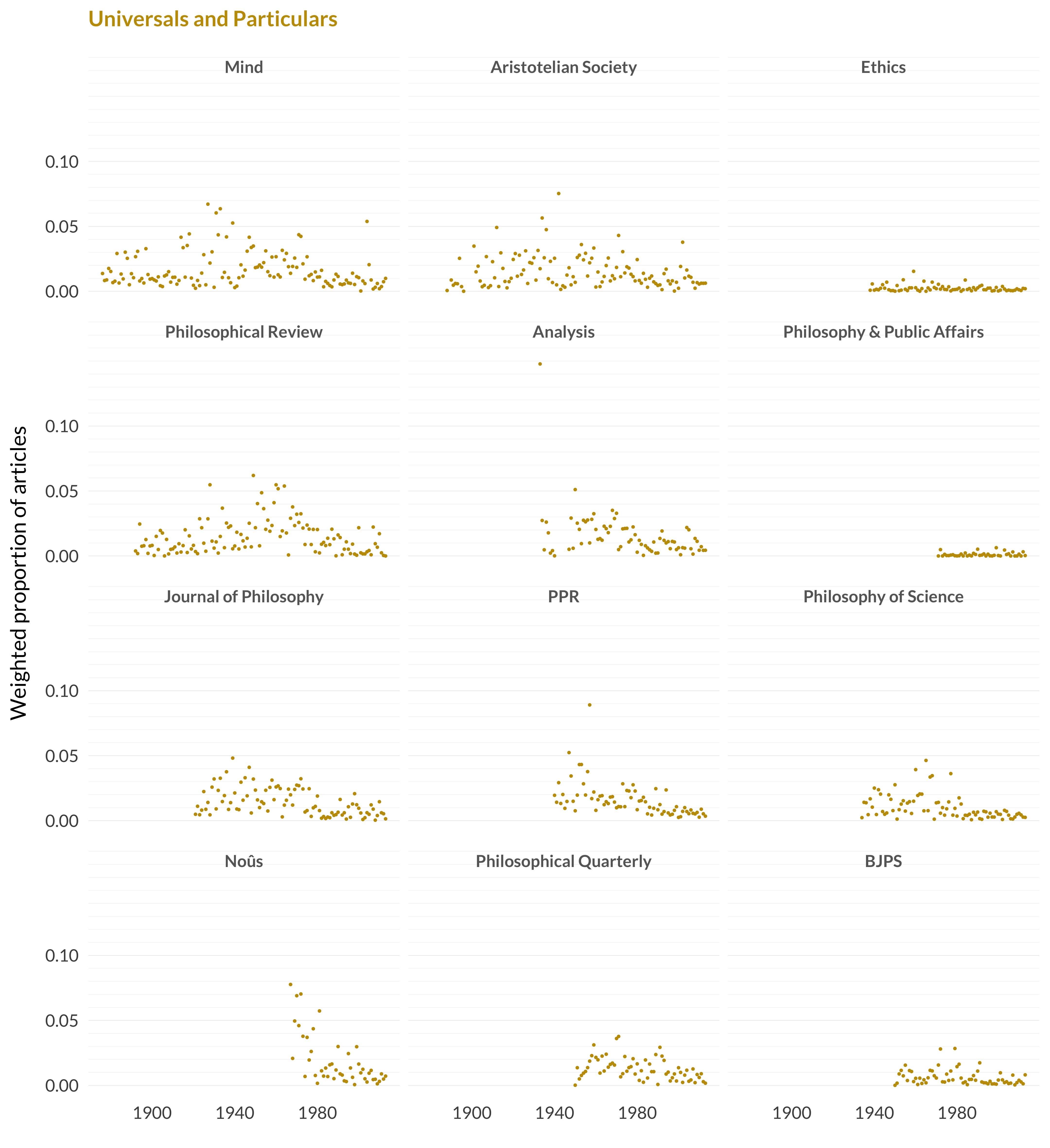2.14 Universals and Particulars
Category: Logic and Mathematics
Keywords: universals, particulars, predication, category, generic, predicates, plural, peirce, categories, predicate, strawson, gold, universal, sign, noun
Number of Articles: 416
Percentage of Total: 1.3%
Rank: 26th
Weighted Number of Articles: 422
Percentage of Total: 1.3%
Rank: 21st
Mean Publication Year: 1958.9
Weighted Mean Publication Year: 1961.3
Median Publication Year: 1962
Modal Publication Year: 1947
Topic with Most Overlap: Ordinary Language (0.0424)
Topic this Overlaps Most With: Definitions (0.0292)
Topic with Least Overlap: Crime and Punishment (0.00019)
Topic this Overlaps Least With: Population Ethics (0.00081)

Figure 2.39: Universals and particulars.

Figure 2.40: Universals and particulars articles in each journal.
Comments
This is a large and long-lasting topic. And it is somewhat disjunctive.
It includes some metaphysics and, indeed some of the things I’d think of as paradigmatic to early analytic metaphysics, such as Russell’s “On the Relations of Universals and Particulars” and Ramsey’s “Universals”. And it includes their contemporary successors, such as Fraser MacBride’s “Could Armstrong Have Been a Universal?”.
It includes some philosophy of language, though surprisingly less than I would have guessed from the keywords. It includes, for example, Wilfrid Sellars’s “Naming and Saying”, and David Liebesman’s “Simple Generics”.
It includes a large amount of Peircean pragmatics. Here is a list just of the articles in the topic with “Peirce” in the title:
- Ernest Nagel, 1933, “Charles Peirce’s Guesses at the Riddle,” Journal of Philosophy 30:365–86.
- Charles W. Morris, 1938, “Peirce, Mead, and Pragmatism,” Philosophical Review 47:109–27.
- Justus Buchler, 1940, “The Accidents of Peirce’s System,” Journal of Philosophy 37:264–9.
- Paul Weiss and Arthur Burks, 1945, “Peirce’s Sixty-Six Signs,” Journal of Philosophy 42:383–8.
- George Gentry, 1946, “Peirce’s Early and Later Theory of Cognition and Meaning: Some Critical Comments,” Philosophical Review 55:634–50.
- John Dewey, 1946, “Peirce’s Theory of Linguistic Signs, Thought, and Meaning,” Journal of Philosophy 43:85–95.
- W. B. Gallie, 1947, “The Metaphysics of C. S. Peirce,” Proceedings of the Aristotelian Society 47:27–62.
- Manley H. Thompson, Jr., 1949, “The Logical Paradoxes and Peirce’s Semiotic,” Journal of Philosophy 46:513–36.
- Edward C. Moore, 1952, “The Scholastic Realism of C. S. Peirce,” Philosophy and Phenomenological Research 12:406–17.
- Ralph J. Bastian, S.j., 1953, “The”Scholastic” Realism of C. S. Peirce,” Philosophy and Phenomenological Research 14:246–9.
- Edward C. Moore, 1953, “Professor Bastian’s Comments on Peirce’s Scholasticism,” Philosophy and Phenomenological Research 14:250–1.
- William P. Alston, 1956, “Pragmatism and the Theory of Signs in Peirce,” Philosophy and Phenomenological Research 17:79–88.
- Otto Bird, 1959, “Peirce’s Theory of Methodology,” Philosophy of Science 26:187–200.
- W. Donald Oliver, 1963, “Peirce on”The Ethics of Terminology”,” The Philosophical Quarterly 13:238–45.
- Joseph Ransdell, 1978, “A Misunderstanding of Peirce’s Phenomenology,” Philosophy and Phenomenological Research 38:550–3.
- Paul Tibbets, 1978, “Peirce’s Phenomenology: A Reply to Professor Ransdell,” Philosophy and Phenomenological Research 38:554–6.
- Ilona Kemp-Pritchard, 1981, “Peirce on Philosophical Hope and Logical Sentiment,” Philosophy and Phenomenological Research 42:75–90.
- Helmut Pape, 1990, “Charles S. Peirce on Objects of Thought and Representation,” Noûs 24:375–95.
And there are other articles too that are about Peirce, or Peircean thought, without including the string Peirce in the title.
But ultimately it is largely a topic about logic. It starts off with articles about Aristotelian logic, then moves into discussions of the role of subject and predicate in contemporary (broadly Fregean) logic. And that’s where the model places it.
And it’s not surprising, given the importance of debates about universals to philosophy from Plato, through Abelard and Ockham, through the present day, that it is one of the largest (and hardest to place) topics.